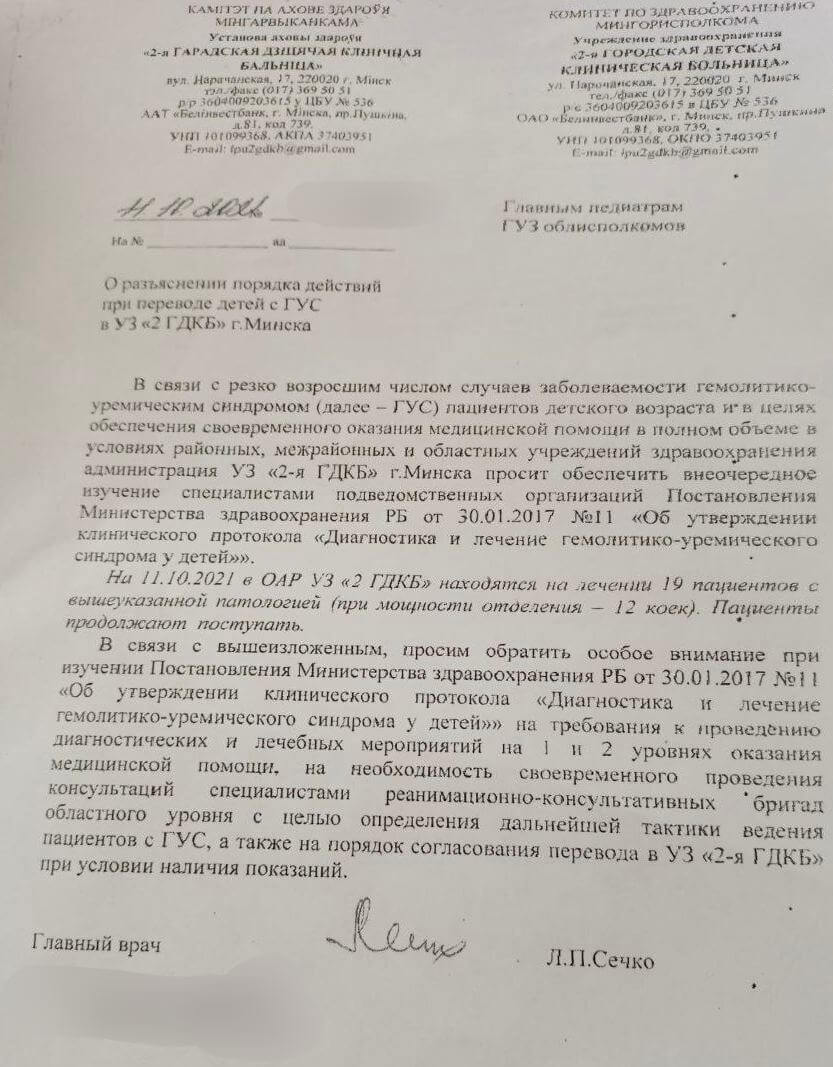На русском языке:
Отравление или COVID-19? В Минске подозрительно много детей с почечной недостаточностью
На беларускай мове:
З Мінска паведамляюць пра масавае атручэнне дзяцей з ускладненнем на ныркі
Over the weekend, the Telegram channel «White Coats» reported that there are suspiciously many patients with hemolytic uremic syndrome (HUS) in children’s hospitals. The number of new cases exceeds last year’s figures, which is very alarming to doctors. At the same time, the editorial staff of Motolko.help receives more and more new reports about the poisoning of children, who are detected to have kidney complications in hospital. Some suggest that bananas may be the cause of the infection.
"About 25 children were poisoned by bananas In Minsk. They are on hemodialysis".
"In addition to a strong cough, some kind of infection has spread among children in kindergartens! Children experience vomiting and diarrhea. Subsequently, the kidneys are failing. More and more new patients are coming to the intensive care unit. Doctors hide information!"
In addition, the editorial office of Motolko.help got a document signed by Larisa Sechko, the Dean of Medicine of the 2nd City Children’s Clinical Hospital in Minsk. The document says that as at October 11, there are 19 patients with hemolytic uremic syndrome in the hospital, when there’re 12 beds in the department. And new patients with this illness continue to come.
Information about similar cases of mass poisoning, due to which children are hospitalized with kidney failure, is shared among parents in chats.
"The most actively discussed version now is that bananas were treated with something, maybe for better preservation, or maybe there were some insecticides on the farm where they were grown. The second most popular version is complications of COVID-19".
"Last week, this information about the poisoning was reported to the City Center of Hygiene and Epidemiology, so that they joined the clarification of causes".
The White Coats data confirm this. The Telegram channel of Belarusian doctors reported that there were 16 children with HUS in one of the children’s hospitals in Minsk in the intensive care unit last weekend. A week ago, there were 22 children with the same syndrome, which is almost twice the bed capacity of the intensive care unit. Children mainly come from Minsk and Vitebsk regions. It should be borne in mind that children in a rather serious condition are transferred to the capital, requiring renal replacement therapy, and it is not known how many children with HUS remain in district hospitals.
Escherichiosis or complication of COVID-19?
Some readers suppose that the appearance of hemolytic uremic syndrome among children may be due to COVID-19, which causes kidney complications.
"Our friend, who is a doctor, says it's a complication of COVID-19. The hospital has 12 hemodialysis machines, 17 such children were admitted last week. And there're small children under a year and one-year-old. We were advised not to go to the kindergarten yet".
"It is a complication of COVID-19. There're a lot of such children in Germany and US".
However, White Coats write that the Center of Disease Control conducted an investigation in this regard. Given the similar clinical signs of complications of coronavirus infection and HUS, children with this syndrome have been tested for COVID, but no connection has yet been found.
The factor that triggers HUS is often escherichiosis, an intestinal infection caused by the pathogen E. coli, which can be found in raw or under-heat-treated products from minced meat, raw milk and vegetables contaminated with feces.
"If the cause of the HUS outbreak is escherichiosis, then it will not be easy to find out. We do not have laboratory diagnostics in wide access, because the best way to combat an infectious disease in the Republic of Belarus is to combat its diagnosis", – one of the readers believes.
After the contact with E. coli, approximately 10–15% of those infected get HUS. The typical patient age for this disease is from six months to six years.
Doctors note that the incidence of HUS in Belarus is one of the highest in Europe. Usually it has its peak in a warm season (May — August).
After becoming infected with E. coli, HUS syndrome occurs on average after three days. The disease begins, as a rule, cramping abdominal pain and non-bloody diarrhea. Within 1-2 days in 45-60% of cases, the stool becomes bloody. In 30-60% of cases, HUS is accompanied by vomiting, in 30% — fever. These symptoms increase the risk of developing HUS along with antibiotics that inhibit intestinal motility.



